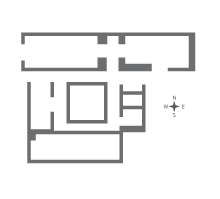Castlelyons Carmelite Priory
 Add to favorites
Add to favorites
Order: Carmelite Order (O. Carm./ Ordo Fratrum Beatissimae Virginis Mariae de Monte Carmelo)
Founded in 1308
Founded by John de Barry
Also known as: Castelio, Castleyhane, Castelleaghan, Castrileonensis
The Place
Castlelyons is a village in east Co. Cork, where a Carmelite friary lies at the corner of Main Street and Rathcormack Lane. It was founded in August 1309 when King Edward II (1284-1327) granted John de Barry (c.1265-1330) the right to give the Carmelite friars of Drogheda a plot of land in Castlelyons. The friary was dedicated to the Blessed Virgin Mary. However, in 1314 the friars had not obtained authorization from the pope to build the friary. Pope John XXII (d.1334) finally gave them the licence to return ten years later. The church was built in the fourteenth century but most of the remaining nave, domestic ranges and the tower date to fifteenth century.
The People
John de Barry (c.1265-1330) was a descendant of Philip de Barry (d. c.1200), who had served under his uncle, Robert Fitzstephen (c.1115–c.1185), during the Anglo-Norman conquest of the kingdom of Cork in 1177. Philip was granted extensive land in east Co. Cork, and the lordship of Castlelyons, Buttevant and Barryscourt was confirmed to his son, William, in 1206.
John inherited the lordship when his father David de Barry III died c. 1290. John was a knight who regularly served in the wars of the kings of England in Scotland and France. He married Maud de Boulltron but died without issue, and the lordship passed to his brother David de Barry IV (d.1347). Before his death, John also granted his other brother William (d.1373) the family’s land in West Cork.
John’s foundation of the Carmelite friary in Castlelyons continued a long family tradition of patronage of the mendicant orders, which had started with the Dominican and Franciscan friaries of Cork city in 1229. John’s great grandfather David I (d. 1261) founded the Franciscan friary at Buttevant, and his grandfather David II was buried in the friary church in 1278. John’s brother William was involved in the foundation of Timoleague Franciscan friary, where he was buried with his wife Margery in 1373.
Why visit?
Castlelyons is one of the few Carmelite friaries in Ireland that has extensive standing remains. The church, the tower, and the east and west ranges still stand, with evidence of conservation work undertaken by the OPW in the 1930s. Notable features include the church’s fifteenth century pointed-arch west doorway, with a stoop on the inside of the door on the left hand-side when entering the nave. A stone altar of an unknown date survives in the choir, as well as late medieval and modern grave slabs covering part of the ground. An anti-clockwise spiral stairway leads up to the top of the three storey tower. The night stairs which the friars would have taken to reach their dormitory in the west range survives in the north-west corner of the cloister walk.
What happened here?
1308: Edward II ordered an inquiry to verify the granting to John de Barry of a licence to give the Carmelites of Drogheda land in Castlelyons
1309: The licence was granted to John on 11 August
1314: The friars were living in Castlelyons without the pope’s permission, having failed to obtain the papal licence allowing them to build a friary there
1324: The friars in Castlelyons eventually received the pope’s permission in a papal licence
At an unknown date, the king gave the friars 20 marks to be taken every year from the income of the town
Prior to 1541: The history of the friary is unknown for large periods of time as it is not mentioned in any official records until its dissolution
1561: The friary was annexed to the crown
1568: Viscount Barrymore was to be granted two of the following monasteries: Ballybeg, Buttevant, Castlelyons, Timoleague
1569: The friary was still in use at this time
1638: Windows from Castlelyons friary were brought to Lismore and used in the renovation of the cathedral there by the Earl of Cork
Prior to 1643: Richard Boyle (1566-1643), 1st earl of Cork was granted Castlelyons, in addition to a number of other religious houses. He granted Castlelyons to his daughter Alice
1737: The friary was re-established
1760: The last titular Carmelite Prior, John O Neil, died
Mid-19th century: John Windele, antiquarian, visited Castlelyons and mentioned that the nave was being used as a ball alley by the villagers
1930s: Some restoration work was undertaken by the OPW

















